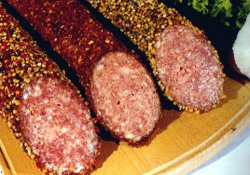Color of Cured Meats in Grocery Store Merchandisers
Curing solutions, which are injected into the meat with a needle or rubbed on the surface of raw meat, usually contain nitric oxide (NO) which reacts with the meat pigment myoglobin to form nitric oxide myoglobin (MbNO), also known as nitrosylmyoglobin or nitrosomyoglobin, a bright red pigment. Even a small amount of nitrite, such as the amount left on an improperly cleaned utensil, can cause the nitric oxide myoglobin pigment to form on other meats such as cooked beef.
This pigment is not very stable, however. If the cured meat is exposed to display light and oxygen, the pigment becomes oxidized and breaks down, forming metmyoglobin nitrite and turning the cured meat gray. Heat can also contribute to nitrite burn, a series of three chemical reactions in which metmyoglobin nitrite reacts with excess nitrous acid to form nitrimetmyoglobin, which reduces to nitrimyoglobin (MbN), which in turn becomes the green pigment nitrihemin when exposed to heat. The green/gray color of cured meats can also be triggered when the meat is contaminated by metals from molds or smoke sticks.
To stabilize the color, cured meats are often vacuum packaged, and one study recommended storing the meat in the dark prior to display. Protecting cured meats from harmful visible spectrum and ultraviolet light, elevated temperatures, and oxygen can help prevent cured meats from turning gray or green.
Ultraviolet and visible spectrum light can also cause the color of cured products (raw or cooked) to fade to a degree in proportion to the intensity of the light multiplied by the length of exposure to light beginning at 200 foot candle hours.

Cured meats such as hams are very sensitive to the effects of ultraviolet light.Cured meats such as hams are very sensitive to the effects of ultraviolet light. The typical pale gray color of raw hams is directly related to pigment transformation and fading triggered by the radiation from ultraviolet and visible spectrum light. With prolonged exposure to light (UV and visible light), oxygen, and the salts and chemicals in the cure, raw cured meats break down chemically and spoil, turning green in the process.
The cured color is much more stable after the meat has been cooked because this process changes the pigment nitric oxide myoglobin to the pink pigment nitric oxide myochromogen, also known as nitrosylmyochrome, nitrosohemochrome, or nitrosylhemochrome. However, the pigment of cooked cured meat is still very sensitive to the discoloring effects of light, temperature, and oxygen, and even cooked cured meats tend to be sold in vacuum packages.
Frozen bacon has a short shelf life compared to other frozen meats because it is sensitive to various oxidative reactions which affect the bacon’s color, appearance, and flavor. The pigment in bacon, nitric oxide myoglobin, reacts with sodium nitrite to form the grey pigment metmyoglobin nitrite, a process that is accelerated by high levels of the salt sodium chloride especially in leaner bacon.
